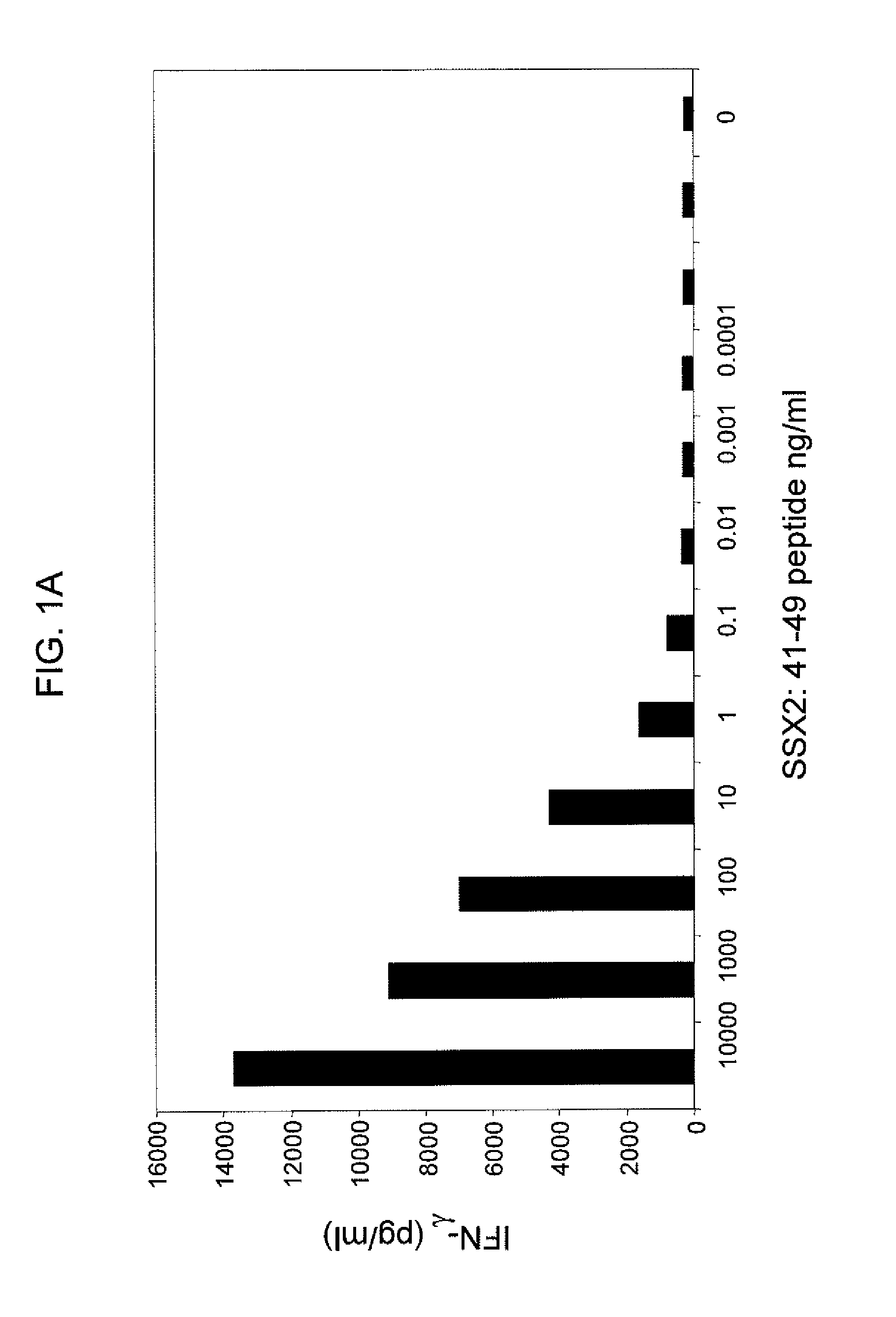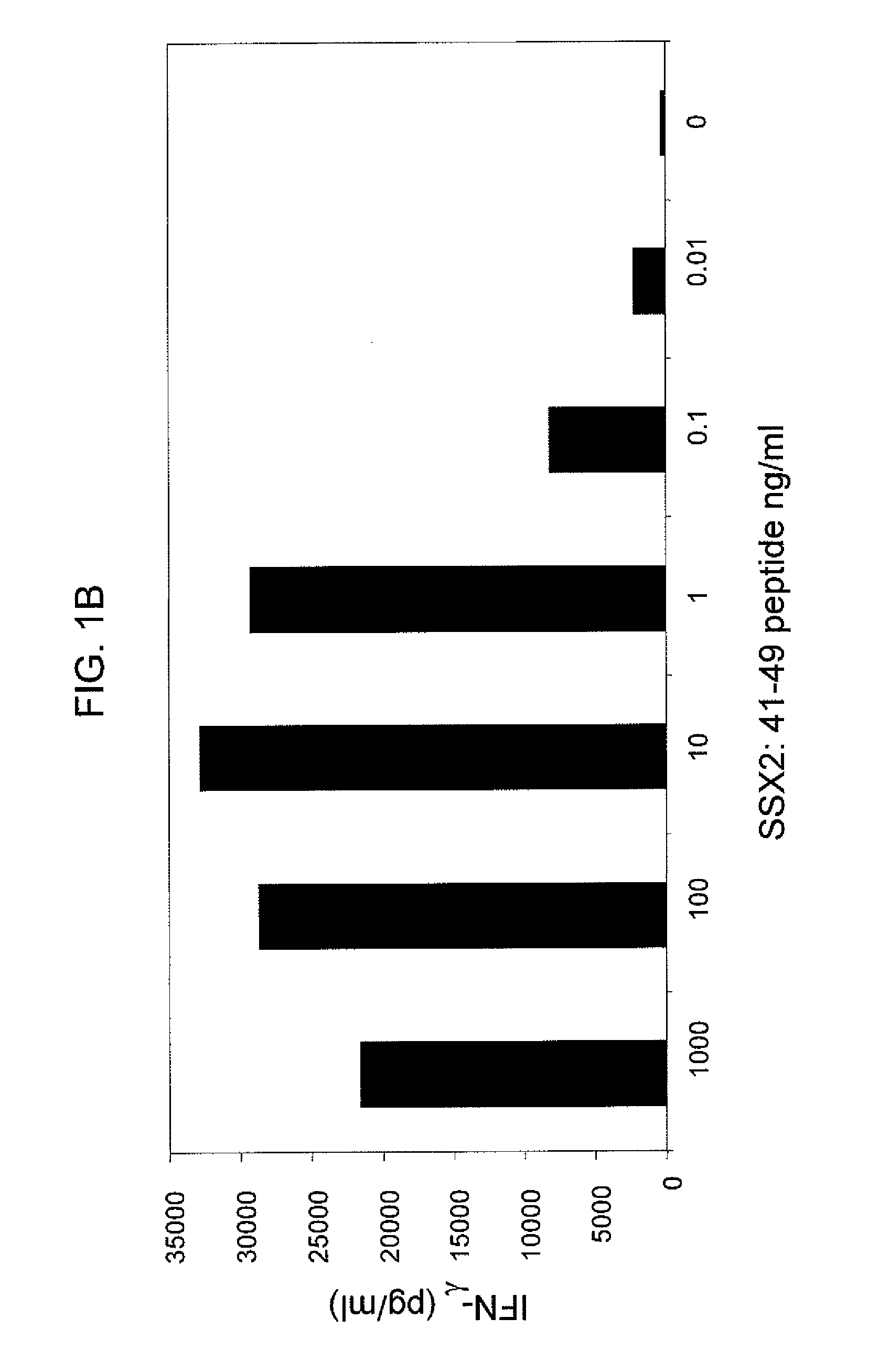Anti-SSX-2 T cell receptors and related materials and methods of use
a technology of t cell receptors and anti-ssx2, which is applied in the direction of depsipeptides, peptide/protein ingredients, fusion polypeptides, etc., can solve the problems of difficult generating human t cell anti-tumor potential, transfer t cell toxic to normal, i.e., non-cancerous tissues,
- Summary
- Abstract
- Description
- Claims
- Application Information
AI Technical Summary
Benefits of technology
Problems solved by technology
Method used
Image
Examples
example 1
[0119]This example illustrates the construction of a retroviral vector for expressing SSX-2 and demonstrates SSX-2 expression in certain cell lines.
[0120]The SSX-2 gene was inserted into expression vectors pMSGV1 and pRRLSIN.cPPT.PGK. The sequence of SSX-2 inserted was:
[0121]
(SEQ ID NO: 31)ATGaacggagacgacgcctttgcaaggagacccacggttggtgctcaaataccagagaagatccaaaaggccttcgatgatattgccaaatacttctctaaggaagagtgggaaaagatgaaagcctcggagaaaatcttctatgtgtatatgaagagaaagtatgaggctatgactaaactaggtttcaaggccaccctcccacctttcatgtgtaataaacgggccgaagacttccaggggaatgatttggataatgaccctaaccgtgggaatcaggttgaacgtcctcagatgactttcggcaggctccagggaatctccccgaagatcatgcccaagaagccagcagaggaaggaaatgattcggaggaagtgccagaagcatctggcccacaaaatgatgggaaagagctgtgccccccgggaaaaccaactacctctgagaagattcacgagagatctggaaatagggaggcccaagaaaaggaagagagacgcggaacagctcatcggtggagcagtcagaacacacacaacattggtcgattcagtttgtcaacttctatgggtgcagttcatggtacccccaaaacaattacacacaacagggacccaaaaggggggaacatgcctggacccacagactgcgtgagagaaaacagaggTGA.
[0122]The pRRLSIN vector also had ...
example 2
[0127]This example illustrates the construction of a retroviral vector for expressing an SSX-2 specific TCR.
[0128]An HLA-A2 restricted TCR from a natural T cell clone was isolated using 5′-RACE from a tumor-infiltrated lymph node (TILN) from a melanoma patient seropositive for SSX-2 and whose tumor expressed SSX-2.
[0129]The T cell clone showed: TRAV14 / DV4*01 (number of bacterial clones positive 21 / 23) and TRBV15*02-CB1 (number of bacterial clones positive 23 / 23).
[0130]A retroviral vector was constructed expressing the TCR α and β chains incorporating the 2a cleavage peptide. Separate PCR reactions for the α chain and the β chain were performed. For the α chain, the forward primer incorporated an NcoI restriction site of ATG. The reverse primer had furin-SGSG-P2a incorporated before the recognition sequence. For the β chain, the forward primer also incorporated furin-SGSG-P2a before the recognition sequence, and the reverse primer had a stop codon and NotI restriction site.
[0131]Upon...
example 3
[0133]This example demonstrates that PBLs engineered with a SSX-2 TCR show SSX-2 peptide specific reactivity and tetramer binding.
[0134]Human donor-derived PBLs were transduced with the SSX-2 TCR vector of Example 2 and tested for peptide reactivity and tetramer binding.
[0135]Tetramer binding was observed in CD4 and CD8 cells.
[0136]SSX-2 TCR-transduced PBLs were co-cultured with T2 cells from two human donors, where the T2 cells were pulsed with varying concentrations of the SSX-2: 41-49 (KASEKIFYV) peptide. FIGS. 1A and 1B show the resulting interferon-γ levels (pg / ml) measured. These data show that SSX-2 TCR-transduced PBLs recognize SSX-2: 41-49 peptide down to 0.01 ng / ml, or less. The differences between FIGS. 1A and 1B may be due to donor variability.
[0137]SSX-2 TCR-transduced PBLs were also co-cultured with cells from Example 1 retrovirally engineered to express the SSX-2 gene. FIG. 2 shows the resulting interferon-γ levels (pg / ml) measured when the PBLs were co-cultured with ...
PUM
| Property | Measurement | Unit |
|---|---|---|
| concentration | aaaaa | aaaaa |
| concentration | aaaaa | aaaaa |
| concentration | aaaaa | aaaaa |
Abstract
Description
Claims
Application Information
 Login to View More
Login to View More - R&D
- Intellectual Property
- Life Sciences
- Materials
- Tech Scout
- Unparalleled Data Quality
- Higher Quality Content
- 60% Fewer Hallucinations
Browse by: Latest US Patents, China's latest patents, Technical Efficacy Thesaurus, Application Domain, Technology Topic, Popular Technical Reports.
© 2025 PatSnap. All rights reserved.Legal|Privacy policy|Modern Slavery Act Transparency Statement|Sitemap|About US| Contact US: help@patsnap.com



